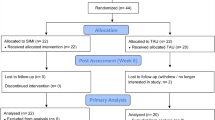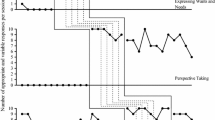Abstract
The social behavior of children and adolescents with Autism Spectrum Disorder was evaluated weekly over 19 weeks of a social skills training program. Participants’ vocalizations were coded as initiating, responding, or other (e.g., self-talk). Participants’ interactions were coded as dyadic peer interactions, dyadic leader interactions, interactions with a group of peers, interactions with a group of peer(s) and leader(s), or time spent by self. Over the course of the intervention, participants made fewer initiating and other vocalizations, more responding vocalizations, spent more time interacting with a group of peers, and spent marginally less time interacting with a leader. Gender, age, and intervention attendance effects on social behavior are also noted.


Similar content being viewed by others
References
Antshel, K. M., Polacek, C., McMahon, M., Dygert, K., Spenceley, L., Dygert, L., et al. (2011). Comorbid ADHD and anxiety affect social skills group intervention treatment efficacy in children with autism spectrum disorders. Journal of Developmental and Behavioral Pediatrics, 32(6), 439–446. doi:10.1097/DBP.0b013e318222355d.
Bakeman, R., & Brownlee, J. R. (1980). The strategic use of parallel play: A sequential analysis. Child Development, 51(3), 873–878. doi:10.2307/1129476.
Baron-Cohen, S., Leslie, A. M., & Frith, U. (1985). Does the autistic child have a “theory of mind”? Cognition, 21(1), 37–46. doi:10.1016/0010-0277(85)90022-8.
Barry, T. D., Klinger, L. G., Lee, J. M., Palardy, N., Gilmore, T., & Bodin, S. D. (2003). Examining the effectiveness of an outpatient clinic-based social skills group for high-functioning children with autism. Journal of Autism and Developmental Disorders, 33(6), 685–701. doi:10.1023/B:JADD.0000006004.86556.e0.
Bauminger, N. (2002). The facilitation of social-emotional understanding and social interaction in high-functioning children with autism: Intervention outcomes. Journal of Autism and Developmental Disorders, 32(4), 283–298. doi:10.1023/a:1016378718278.
Bauminger, N. (2007a). Brief report: Group social-multimodal intervention for HFASD. Journal of Autism and Developmental Disorders, 37(8), 1605–1615. doi:10.1007/s10803-006-0246-3.
Bauminger, N. (2007b). Brief report: Individual social-multi-modal intervention for HFASD. Journal of Autism and Developmental Disorders, 37(8), 1593–1604. doi:10.1007/s10803-006-0245-4.
Berndt, T. J. (2004). Children’s friendships: Shifts over a half-century in perspectives on their development and their effects. Merrill-Palmer Quarterly, 50(3), 206–223. doi:10.1353/mpq.2004.0014.
Berument, S. K., Rutter, M., Lord, C., Pickles, A., & Bailey, A. (1999). Autism screening questionnaire: Diagnostic validity. British Journal of Psychiatry, 175, 444–451. doi:10.1192/bjp.175.5.444.
Constantino, J. (2004). The social responsiveness scale. Los Angeles: Western Psychological Services.
de Bruyn, E. H., & Cillessen, A. H. N. (2008). Leisure activity preferences and perceived popularity in early adolescence. Journal of Leisure Research, 40(3), 442–457.
Dingfelder, H. E., & Mandell, D. S. (2011). Bridging the research-to-practice gap in autism intervention: An application of diffusion of innovation theory. Journal of Autism and Developmental Disorders, 41(5), 597–609. doi:10.1007/s10803-010-1081-0.
Ehlers, S., Gillberg, C., & Wing, L. (1999). A screening questionnaire for Asperger syndrome and other high-functioning autism spectrum disorders in school age children. Journal of Autism and Developmental Disorders, 29(2), 129–141. doi:10.1023/a:1023040610384.
Elliott, S. N., & Gresham, F. M. (1987). Children’s social skills: Assessment and classification practices. Journal of Counseling & Development, 66(2), 96–99. doi:10.1002/j.1556-6676.1987.tb00808.x.
Feiring, C., & Lewis, M. (1991). The transition from middle childhood to early adolescence: Sex differences in the social network and perceived self-competence. Sex Roles, 24(7–8), 489–509. doi:10.1007/BF00289335.
Gillespie-Lynch, K., Sepeta, L., Wang, Y., Marshall, S., Gomez, L., Sigman, M., et al. (2012). Early childhood predictors of the social competence of adults with autism. Journal of Autism and Developmental Disorders, 42(2), 161–174. doi:10.1007/s10803-011-1222-0.
Gresham, F. M. (1997). Social competence and students with behavior disorders: Where we’ve been, where we are, and where we should go. Education & Treatment of Children, 20(3), 233–249.
Hillier, A., Fish, T., Cloppert, P., & Beversdorf, D. Q. (2007). Outcomes of a social and vocational skills support group for adolescents and young adults on the autism spectrum. Focus on Autism and Other Developmental Disabilities, 22, 107–115. doi:10.1177/10883576070220020201.
Koenig, K., De Los Reyes, A., Cicchetti, D., Scahill, L., & Klin, A. (2009). Group intervention to promote social skills in school-age children with pervasive developmental disorders: Reconsidering efficacy. Journal of Autism and Developmental Disorders, 39(8), 1163–1172. doi:10.1007/s10803-009-0728-1.
Kuo, M., Orsmond, G., Cohn, E., & Coster, W. (2011). Friendship characteristics and activity patterns of adolescents with an autism spectrum disorder. Autism,. doi:10.1177/1362361311416380.
Laugeson, E. A., Frankel, F., Mogil, C., & Dillon, A. R. (2009). Parent-assisted social skills training to improve friendships in teens with autism spectrum disorders. Journal of Autism and Developmental Disorders, 39(4), 596–606. doi:10.1007/s10803-008-0664-5.
LeGoff, D. B. (2004). Use of LEGO© as a therapeutic medium for improving social competence. Journal of Autism and Developmental Disorders, 34(5), 557–571. doi:10.1007/s10803-004-2550-0.
Lerner, M. D., Hileman, C. M., & Britton, N. (in press). Promoting the social and emotional development of adolescents with autism spectrum disorder. In T. Gullotta & C. Leukefeld (Eds.), Encyclopedia of primary prevention and health promotion: Adolescence (Vol. 3, 2nd ed). New York: Springer.
Lerner, M., & Mikami, A. (2012). A preliminary randomized controlled trial of two social skills interventions for youth with high functioning autism spectrum disorders. Focus on Autism and Other Developmental Disabilities, 27(3), 147–157. doi:10.1177/1088357612450613.
Levitt, M. J., Guacci-Franco, N., & Levitt, J. L. (1993). Convoys of social support in childhood and early adolescence: Structure and function. Developmental Psychology, 29(5), 811–818. doi:10.1037/0012-1649.29.5.811.
Lopata, C., Volker, M. A., Putnam, S. K., Thomeer, M. L., & Nida, R. E. (2008). Effect of social familiarity on salivary cortisol and self-reports of social anxiety and stress in children with high functioning autism spectrum disorders. Journal of Autism and Developmental Disorders, 38(10), 1866–1877. doi:10.1007/s10803-008-0575-5.
Lord, C., Rutter, M., DiLavore, P., & Risi, S. (2002). Manual: Autism diagnostic observation schedule. Los Angeles, CA: Western Psychological Services.
Lord, C., Rutter, M., & Le Couteur, A. (1994). Autism diagnostic interview—revised: A revised version of a diagnostic interview for caregivers of individuals with possible pervasive developmental disorders. Journal of Autism and Developmental Disorders, 24(5), 659–685. doi:10.1007/BF02172145.
McMahon, C. M., Lerner, M. D., & Britton, N. (in press). Group-based social skills interventions for adolescents with higher-functioning autism spectrum disorder: A review and looking to the future. Adolescent Health, Medicine, and Therapeutics.
McNelles, L. R., & Connolly, J. A. (1999). Intimacy between adolescent friends: Age and gender differences in intimate affect and intimate behaviors. Journal of Research on Adolescence, 9(2), 143–159. doi:10.1207/s15327795jra0902_2.
Merrell, K. W. (2001). Assessment of children’s social skills: Recent developments, best practices, and new directions. Exceptionality, 9(1–2), 3–18. doi:10.1207/S15327035EX091&2_2.
Messinger, D. S., Mahoor, M. H., Chow, S., & Cohn, J. F. (2009). Automated measurement of facial expression in infant–mother interaction: A pilot study. Infancy, 14(3), 285–305. doi:10.1080/15250000902839963.
Mundy, P., & Newell, L. (2007). Attention, joint attention, and social cognition. Current Directions in Psychological Science, 16(5), 269–274. doi:10.1111/j.1467-8721.2007.00518.x.
Owens, G., Granader, Y., Humphrey, A., & Baron-Cohen, S. (2008). LEGO® therapy and the social use of language programme: An evaluation of two social skills interventions for children with high functioning autism and Asperger syndrome. Journal of Autism and Developmental Disorders, 38(10), 1944–1957. doi:10.1007/s10803-008-0590-6.
Rao, P. A., Beidel, D. C., & Murray, M. J. (2008). Social skills interventions for children with Asperger’s syndrome or high-functioning autism: A review and recommendations. Journal of Autism and Developmental Disorders, 38(2), 353–361. doi:10.1007/s10803-007-0402-4.
Raudenbush, S., & Bryk, A. (2002). Hierarchical linear models: Applications and data analysis methods (2nd ed.). Thousand Oaks: Sage Publications, Inc.
Ruble, L., Willis, H., & Crabtree, V. M. (2008). Social skills group therapy for autism spectrum disorders. Clinical Case Studies, 7(4), 287–300. doi:10.1177/1534650107309450.
Singer, J., & Willett, J. (2003). Modeling longitudinal data analysis: Modeling change and even occurrence. New York: Oxford University Press, Inc.
Solomon, M., Goodlin-Jones, B. L., & Anders, T. F. (2004). A social adjustment enhancement intervention for high functioning autism, Asperger’s syndrome, and pervasive developmental disorder NOS. Journal of Autism and Developmental Disorders, 34(6), 649–668. doi:10.1007/s10803-004-5286-y.
Vismara, L. A., & Rogers, S. J. (2010). Behavioral treatments in autism spectrum disorder: What do we know? Annual Review of Clinical Psychology, 6, 447–468. doi:10.1146/annurev.clinpsy.121208.131151.
Way, N., & Greene, M. L. (2006). Trajectories of perceived friendship quality during adolescence: The patterns and contextual predictors. Journal of Research on Adolescence, 16(2), 293–320. doi:10.1111/j.1532-7795.2006.00133.x.
Wechsler, D. (1999). Wechsler abbreviated scale of intelligence (WASI). San Antonio: Harcourt Assessment.
White, S. W., Keonig, K., & Scahill, L. (2007). Social skills development in children with autism spectrum disorders: A review of the intervention research. Journal of Autism and Developmental Disorders, 37(10), 1858–1868. doi:10.1007/s10803-006-0320-x.
Acknowledgments
This research was supported by two grants from the National Institute of Mental Health: a T32 Institutional Research Training Grant (PI: Sally Rogers, 5-T32MH073124-06) and a K-08 Career Development Award (PI: Marjorie Solomon, 1-K-08 MH074967-01). The authors thank Susan Bacalman, Scott Birkestrand, Ryan Dent, Anthony Evaristo, Erika Frieze, Niki Ghaderi, Joan Gunther, Claire Hara, Mussarat Iqbal, Mandy Pietrykowski, Aimee Sands, Andrea Schneider, Fiona Tsang, and Kelsey Urauchi for their contributions.
Conflict of interest
The first and second authors declare that they have no conflict of interest. The third author declares a potential conflict of interest, as she receives financial compensation for her clinical role in the intervention.
Author information
Authors and Affiliations
Corresponding author
Rights and permissions
About this article
Cite this article
McMahon, C.M., Vismara, L.A. & Solomon, M. Measuring Changes in Social Behavior During a Social Skills Intervention for Higher-Functioning Children and Adolescents with Autism Spectrum Disorder. J Autism Dev Disord 43, 1843–1856 (2013). https://doi.org/10.1007/s10803-012-1733-3
Published:
Issue Date:
DOI: https://doi.org/10.1007/s10803-012-1733-3




